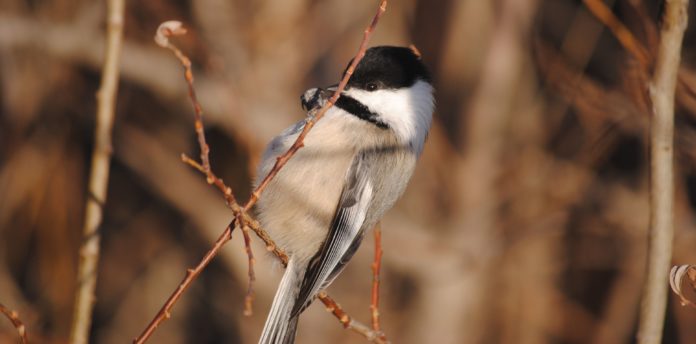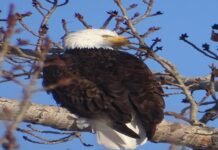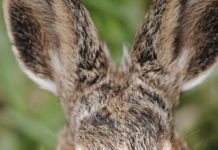by J.G. Turner | Photo by Andrea S. H. Hunt
There are three types of chickadees habitually living in Alberta: the Black-capped, Boreal, and Mountain Chickadees. They are all songbirds with slightly different but overlapping (conifer forest) habitats. It can sometimes be tricky to figure out which type you are hearing or seeing. They are all known for the part of their song that gives this bird its name – “chick-a-dee-dee-dee”.
These three types of chickadees are much alike in their mating (monogamous) and nesting behaviours, feeding styles and food preferences, flight patterns, food hoarding behaviours and physiological adaptations for winter. They are frequently in mixed flocks, so it is very hard to tell them apart by sight or sound, but fun to try!
Fun Chickadee Information:
- The chickadee is one of the most important pest exterminators in the forest and is a hard-working little bird. It eats huge amounts of insect eggs, larvae and pupae; caterpillars, sawflies, other insects and spiders. They will even hang upside down to access food!
- Chickadees spend most of their day feeding and are so good at finding food that other birds (such as nuthatches and warblers) hang around to hear the call that means a good source of food has been found. Most of its diet consists of invertebrates during the breeding season, and invertebrates are about half of its diet during the winter (the rest being berries, nuts and seeds rich in fat).
- When there is a lot of food, and in the late summer and fall, the chickadee becomes a food hoarder. It carefully hides food under a piece of bark, in a knothole or in a patch of lichen or foliage. A chickadee may cache many dozens of food items in a single day and can find these hours and even many days later (up to 4 weeks) … filling its ‘cupboards’ for when food supplies run low. It even remembers when it has used up a food cache.
- A Chickadee has the skills and a special ability that makes it a uniquely adapted bird for Alberta winters. It knows how to find good roosting spots to shelter from the cold winter nights (in holes in trees, dense evergreens or thick bushes). To keep warm the chickadee stands up its soft, dense, thick ‘winter’ under-feathers to trap warm air close to its body to serve as good insulation against the cold (sort of like a parka).
- Even more notable is the Chickadee’s ability to drop its body temperature at night by 6-10° C below its daytime body temperature. This allows it to save energy and insulating fat (although it does take a while to warm up and get going in the morning). Its hard work finding and storing food comes into play here too, as food not needed for the immediate activity of moving around and foraging for more food is stored as body fat. This fat provides the energy that the chickadee needs to survive while sleeping and fasting through the long, cold Alberta winter nights. The foods (such as raw sunflower seeds, shelled unsalted peanuts, suet) offered at our backyard bird feeding stations in winter really help this little bird survive the cold.
Chickadees are engaging, gregarious, entertaining little songbirds that make bird feeder observing and walking in the woods fun in any season.
If you find an injured or orphaned Chickadee or other wild bird or animal, please contact the Calgary Wildlife Rehabilitation Society at 403-239-2488 for tips, instructions and advice, or look at the website at www.calgarywildlife.org for more information.










